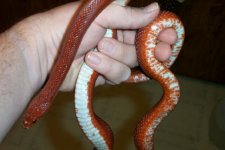<i>I posted this thread on 'some other corn forum', I figured I'd ask here as well to get as many opinions as possible.</i>
With all the talk recently about bloods and motleys and what is/is not a bloodred, I just have a general consensus question to ask (as well as the need to get an acceptable standard for 'bloodred' together to put in the Corn Morph Standards that are presently being compiled by committee).
I would like to ask everyone what their opinion is of the "bloodred" morph, more specifically the part of bloodred that defines it AS a bloodred. It seems to me (and I am by no means an expert) that there is a more-or-less recessive bloodred (incompletely codominant?) pattern gene at work that has very little to do with how red the animal is...which would make the name 'bloodred' somewhat of a misnomer. True, these guys have been selectively bred to enhance the reds, and I think the pattern trait has a 'smudging' effect on the melanin which would enhance the appearance of a bloodred's reds (much like the hypo effect, imho) which tends to reduce the pattern with time, but do you really think the 'red' of a bloodred has anything to do with the "bloodred gene"? Are our brightest and best red-colored bloods just very nice examples of selectively bred 'bloodred' pattern morphed corns?
In my opinion, I define a bloodred by the pattern...plain belly (with or without color encroaching/peppering the edges, etc.), smudging/smearing/reduction of side pattern, stretched head pattern with grey heads (or whitish depending on the morph) as hatchlings, and a diminishing of dorsal pattern with time.
Let's hear some discussion on this morph. I hope it will greatly help with 'defining' the morph and trying to come to some agreement on it.
Thanks for your opinions and help,
Hurley
With all the talk recently about bloods and motleys and what is/is not a bloodred, I just have a general consensus question to ask (as well as the need to get an acceptable standard for 'bloodred' together to put in the Corn Morph Standards that are presently being compiled by committee).
I would like to ask everyone what their opinion is of the "bloodred" morph, more specifically the part of bloodred that defines it AS a bloodred. It seems to me (and I am by no means an expert) that there is a more-or-less recessive bloodred (incompletely codominant?) pattern gene at work that has very little to do with how red the animal is...which would make the name 'bloodred' somewhat of a misnomer. True, these guys have been selectively bred to enhance the reds, and I think the pattern trait has a 'smudging' effect on the melanin which would enhance the appearance of a bloodred's reds (much like the hypo effect, imho) which tends to reduce the pattern with time, but do you really think the 'red' of a bloodred has anything to do with the "bloodred gene"? Are our brightest and best red-colored bloods just very nice examples of selectively bred 'bloodred' pattern morphed corns?
In my opinion, I define a bloodred by the pattern...plain belly (with or without color encroaching/peppering the edges, etc.), smudging/smearing/reduction of side pattern, stretched head pattern with grey heads (or whitish depending on the morph) as hatchlings, and a diminishing of dorsal pattern with time.
Let's hear some discussion on this morph. I hope it will greatly help with 'defining' the morph and trying to come to some agreement on it.
Thanks for your opinions and help,
Hurley


